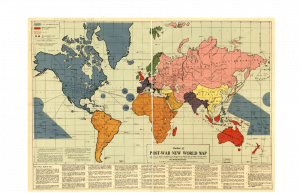Maurice Gomberg is the author of this interesting map. We don’t know a lot about Gomberg besides that he was teacher from Philadelphia and that he self published this map. Gombergs ideas are radical and interesting. He is a pacifist and wants wars to end as he calls for the disarming of militaries. He believes that the United States has the responsibility to lead the world after the war is over. He says that United States is in better economic state and has the best geographic location to run the world. He wants to establish a world court and world league of nationalities to run the relinquished countries and to help re-establish society in Europe. He also wants to ban all Germans and Japenese from the Western Hemisphere. A final interesting note is Gomberg’s idea to rename and consolidate countries like renaming South America and its counties to the United States of South America.
As Gomberg describes it, this map is an “Outline of Post-War New World Map as the U.S.A., with the cooperation of the Democracies of Latin America, the British Commonwealth of Nations and the Union of Soviet Socialist Republics, assumes world leadership for the establishment of a New World Moral Order for permanent peace, freedom, justice, security and world reconstruction.” He created this post World War II prediction before the allied victory as a very optimistic forecast of the post-war “New World” that he envisioned, with regions (instead of countries) divided between British, Soviet, and U.S. control. His ideas were very controversial because he eliminated the idea of countries, put all the world control in the hands of few, and made the north more powerful with his pro-US and allies viewpoint, especially through his use of the Mercator projection. One particularly interesting feature of Gomberg’s map is his legend. The map is colored in regions, the 3 primary colors being blue for the U.S.A. and Protectorates, red for the British Commonwealth of Nations, and pink for the U.S.S.R. However, there are smaller regions on the map in various colors, such as green, yellow, orange, and purple, which he chose not to include in the legend, therefore indicating the author doesn’t view them as important and wants to draw attention away from them.

